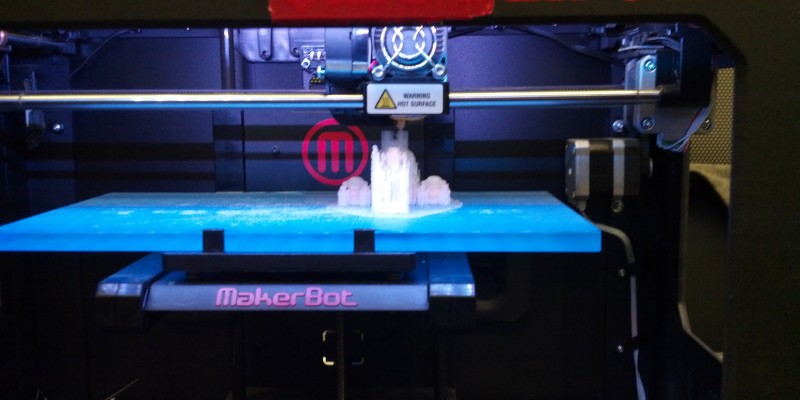Second only to the holodeck, the replicator is the piece of Star Trek technology I’ve always wanted the most. Sure, transporters and warp drives are damn useful for conquering space-time, but for meeting material needs, the replicator wins. Luckily, a replicator also seems to be a lot closer to actually happening than the former two.
At the SXSWedu in Austin, TX, educators and technologists strive to collaborate for the benefit of students everywhere, which explains why there’s a maker room at the conference. The maker movement is a community with DIY as its ideal. It’s hands-on in the extreme. Education can so often be academic in the figurative sense of the word, hands off and theoretical only. For some kids, that approach doesn’t work at all, but hands-on education flips the switch that allows them to learn.
In the SXSWedu Conference maker room are two MakerBot Replicator 2 Desktop 3D Printers. Makerbot even named the device a Replicator, and rightly so, as it’s a huge step in the direction of the Star Trek replicator. If you haven’t heard about this technology yet (and that’s doubtful at this point), a 3D printer takes a digital model and automatically builds a three-dimensional physical model. Here’s an explanation of that again to really drive home how fantastic the concept and act is in three easy steps.
- An idea exists in your head.
- You use software to design a three-dimensional model of your idea.
- You output that model to a 3D printer, which builds your idea in the physical world.
When someone gets around to attaching voice activation of a catalog of designs, we’ll essentially have a first-generation Star Trek replicator.
The 3D printers work by slowly adding layers of plastic and building up a model. Raw material can be filament of at least two types: acrylonitrile butadiene styrene (ABS) plastic or polylactic acid (PLA), which is corn, tapioca, or sugarcane based. The printer I observed most closely at SXSWedu used an environmentally-friendly and corn-based PLA. All that is to say that there’s a spool of material that unwinds into the printer, is melted, and extruded onto the three-dimensional model layer by layer. The process happens automatically, much like a two-dimensional printer. You send your file to the printer and wait, except that instead of paper, you have “tea, earl grey, hot.”
Well, not quite, but the finished product is impressive.
The two MakerBots are printing a variety of interesting items for demonstration. There are several small toys including a robot and a waving octopus as well as items that show off the functionality of the printers such as a chain of links. Perhaps one of the more obvious uses of 3D printers is prototyping. To obtain a prototype of even a small item can cost tens or even hundreds of thousands of dollars. A 3D printer can provide a prototype for a fraction of the cost and time. While at the convention, I heard an anecdote about a man who needed a small part for a piece of exercise equipment. The manufacturer wanted to charge him $65 for the part. Instead, the man produced the part on his 3D printer for less than $5. It’s easy to see how such uses could be found everywhere.
However, the benefits and ramifications of 3D printing quickly become larger with the following real-world examples.
- NASA is currently investigating using 3D printing to produce spare parts for the International Space Station. The agency can launch up a heavy load of spare parts or send up 3D printing equipment and raw material to print only what it needs.
- A very young girl named Emma, who suffers from a muscular condition that prohibits her from using her arms, benefits from the use of an exoskeleton. However, because of her small size and the size of the exoskeleton, her use of the exoskeleton is limited. Researchers used a 3D printer to print out a special harness and fittings customized for her. When Emma outgrew the printed devices, the researchers simply printed a larger set.
- In 2012, an American gunsmith recently became the first person to print a working firearm with a 3D printer. The gun reportedly fired six shots before falling apart.
Just let your mind wander into all the possible scenarios presented by the above examples. It’s truly stunning, particularly when you consider that the technology is new and surprisingly accessible. A MakerBot Replicator 2 costs around $2,200, one kilogram of raw material is around $50, and this technology is only a few years old.
If you can’t afford a 3D printer just yet, I’m sure the replicator has one on file.


Comments are closed.